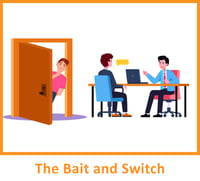
As the pandemic began, recruiters, along with the rest of the world, had to modify our way of doing business (and life in general). Suddenly, working from home wasn’t just a convenience – it was a necessity. As the Director of Talent Acquisition at CC Pace, remote work wasn’t a seismic shift for my team as I’ve long believed that recruiting can be done effectively from home. We could continue to source, screen, and pipeline candidates from our home office and still manage to meet candidates face-to-face throughout the interview process… just with one small change (enter the video chat). However, that small change had a bigger impact than I ever anticipated.
With remote work becoming the norm, professional ‘norms’ started to evolve – and not all for the better. New challenges emerged that were unprecedented. As if recruiters didn’t already have a tough time finding top-notch candidates that fit in with team and company dynamics, a slew of new challenges were introduced. Among them is the fake candidate.
Fake candidates come in many forms. If you’ve been involved with recruiting or hiring for technical positions, you’re probably chuckling to yourself (or cringing if I’m bringing up suppressed trauma) because you know what I’m talking about. If you’re one of the lucky ones who hasn’t been personally victimized by fake candidates, allow me to elaborate.
Breaking Down the Fake Candidate Personas
 First, we’ll start with the ‘classic counterfeit’, which is a candidate who has a fake resume. These are real people who concoct a fake work history tailored to fit the needs of the position they are seeking. These resumes generally include fictional skills and fictional employers. In my experience, counterfeit candidates are doing this to get higher-paying jobs and are prevalent within the corp-to-corp contract/freelance world.
First, we’ll start with the ‘classic counterfeit’, which is a candidate who has a fake resume. These are real people who concoct a fake work history tailored to fit the needs of the position they are seeking. These resumes generally include fictional skills and fictional employers. In my experience, counterfeit candidates are doing this to get higher-paying jobs and are prevalent within the corp-to-corp contract/freelance world.
 Then there is the ‘bait and switch’ applicant (this is a particularly infuriating one). This approach happens when unethical companies bring candidates to the US, sponsor their visas, and tremendously inflate their resumes, marketing the candidate as a highly skilled technical consultant. Again, the company is trying to recoup its investment quickly. This scenario might sound familiar to the ‘counterfeit candidate,’ and so far, it is. Cue the ‘bait and switch’. This happens when a technical interview is scheduled, and a very senior, highly skilled technical person takes the interview and lands the job, only to have a lesser qualified or even unqualified individual show up for the job. Seriously, who would ever think that this is acceptable?! But sadly, it happens.
Then there is the ‘bait and switch’ applicant (this is a particularly infuriating one). This approach happens when unethical companies bring candidates to the US, sponsor their visas, and tremendously inflate their resumes, marketing the candidate as a highly skilled technical consultant. Again, the company is trying to recoup its investment quickly. This scenario might sound familiar to the ‘counterfeit candidate,’ and so far, it is. Cue the ‘bait and switch’. This happens when a technical interview is scheduled, and a very senior, highly skilled technical person takes the interview and lands the job, only to have a lesser qualified or even unqualified individual show up for the job. Seriously, who would ever think that this is acceptable?! But sadly, it happens.
 My final example (save the best for last, right?) is a new emergent class of faker: ‘the moonlighter.’ You’ve heard of this! Just as the nickname suggests, this is the candidate who has the skills and experience to land a great job. However, instead of landing a great remote job (with a great salary), they decide to accept two full-time jobs (or maybe more!) and work them simultaneously, doing just enough to get by. Not only is that unethical (and a sure way to get fired fast), but it’s also giving the rest of the remote workers a bad name.
My final example (save the best for last, right?) is a new emergent class of faker: ‘the moonlighter.’ You’ve heard of this! Just as the nickname suggests, this is the candidate who has the skills and experience to land a great job. However, instead of landing a great remote job (with a great salary), they decide to accept two full-time jobs (or maybe more!) and work them simultaneously, doing just enough to get by. Not only is that unethical (and a sure way to get fired fast), but it’s also giving the rest of the remote workers a bad name.
While we’ve tried to make light of these new challenges, in all seriousness, they have really complicated the job market. It impacts recruiters and employers in the worst of ways. Experienced recruiters have become very savvy at identifying these folks early in the process, although you can never be 100% sure 100% of the time. However, you can look at individual red flags and make a reasonable judgment. Here are a few of the red flags that can help you identify the real candidates from the pretenders. Note -some ‘legit candidates may show one or two of the signs below, but if more than a few of these concerns arise, further investigation may be warranted.
When verifying a candidate on their LinkedIn profile, be wary/concerned if:
- They don’t list their full name
- No details or limited information is provided (especially education)
- They don’t have a photo (or use a stock photo, cartoon image, etc.)
- A very low number of LinkedIn connections
- They show no upward progression in their job history; only senior-level positions are visible
- Work history only shows large worldwide companies (which makes it difficult to verify on social media)
When conducting a video interview, be aware of:
- Video: Not turning on the camera and/or, when asked to use video, giving an excuse as to why they cannot do this.
- Long Pauses: When answering questions, the candidate appears to be reading a script or ‘Googling’ to look for answers.
- Mute: If you notice audio going on and off, along with a delay in answering questions, your spidey senses are probably going off (and for good reason!).
- Other Red Flags:
- Sharing strange phone numbers that don’t line up with past or current physical locations.
- Giving generic descriptions of their role and projects they have worked on.
- Lacking knowledge of the companies they have worked for in the past.
- Requiring 100% remote, even if the position is located in the area they claim to reside.
Hopefully, these tips help to protect your organization from hiring a fake candidate (or you feel like you have a support group if this is something you’ve experienced yourself). While you can’t be 100% sure every suspicious resume is a fake, our goal is to find the right, real candidates for our clients – every time. At CC Pace, we’ve instituted a lot of standard procedures to help us identify and eliminate the fake candidates from the get-go so that you never have to experience a counterfeit candidate, a bait-and-switch, or a moonlighter at your organization! Give us a call if this is something you need help with!
More from the blog
View All Blog PostsTime to check your leaky faucets!
Continue ReadingDriving Business Outcomes through Better Engagement: A programmatic approach
Continue ReadingNavigating Challenges in Non-Prime Auto Lending: A Client's Journey
Continue ReadingSubscribe to Our Blog
Fill out your email address to receive notifications about new blog posts from CC Pace!

